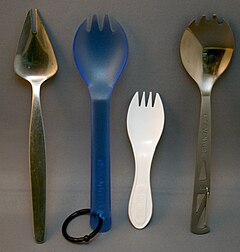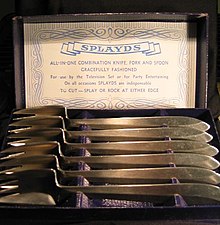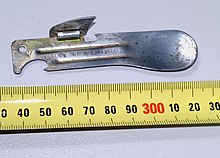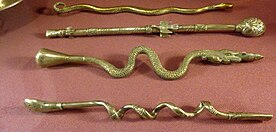Combination eating utensils, also known as hybrid utensils, are utensils that have the qualities of other utensils combined into one. This can be done to make a more convenient, less wasteful, or more cost-efficient product. Many different types of combination utensils have been created, each designed to serve a different purpose.
The best known and commonly used combination utensil is the spork, a combination spoon and fork.
Spork
Main article: Spork
Sporks are a type of combination utensil that combine the functions of a spoon and fork. Sporks have been around for a long time, some utensils resembling sporks being found as far back as 1894. The word "spork" was first referenced in the Century Dictionary in 1909, calling it a portmanteau of spoon and fork, describing it as a long, slender spoon that possesses fork-like tines. The spork is easily one of the most identifiable and popularly used hybrid utensil in modern times, being used in prisons, schools, restaurants, and many other institutions. According to The Washington Post, approximately 35% of American adults own a spork. The name "Spork" was first trademarked in 1970 by the Van Brode Milling Company.
Other variations of the spork include the ice cream fork, which looks very similar in resemblance to the spork, and was actually invented before the spork during the Victorian Era. Even earlier versions and artifacts of combining a spoon and fork can be found from the Dutch, with some estimated to be from the 17th to 19th century. In Finnish, there is a word for spork, Lusikkahaarukka, literally meaning spoon-fork. It does the same job as the spork by combining the functions of a spoon and a fork together, although instead of combining them into single-part utensil, it is composed of two parts, a spoon and a fork, linked together by a joint. It is typically used by the Finnish military.
Ramen spork
A ramen spork is a form of spork designed by Masami Takahashi to eliminate waste produced by disposable chopsticks. The design consists of a spoon with four prongs that extend directly from the front rim of the spoon, rather than a cup with incisions made to create tines as usually seen on the traditional spork design. It was originally designed for the popular Japanese ramen chain, Sugakiya, in 2007. It was made to easily eat ramen by being able to twirl the noodles with the prongs and then ladle the soup with the spoon part, as described by the Museum of Modern Art, which sells the utensil. It is also sold by the Japanese American National Museum store.
Spork Chops

Spork Chops are a type of combination utensil, similar to the chork, that combine chopsticks with a fork and spoon. On one stick, there is a two-prong fork, and on the other stick, there is a small spoon. Like the chork, it's made to accommodate those who have difficulties using chopsticks, while preserving the chopsticks function for those who do know how to use them. They can also be used to be able to eat certain foods, such as noodle soup, which may need a spoon, fork, and chopsticks. They are available for sale in various websites, notably at the Carnegie Museums of Pittsburgh store.
Splayd
Main article: Splayd
Splayds are a type of combination utensil that combine the functions of the three main eating utensils: forks, spoons, and knives. It was invented in the 1940s in Australia by William McArthur after he saw people having difficulty balancing all their utensils and their plate. In other words, it was invented for convenience so that people wouldn't need three different utensils to eat. By the 1990s, it had been sold in 52 countries, with over 5 million pieces worldwide.
Tritensil
A different design of combining the three main eating utensils of forks, spoons, and knives was created by Map Project Office, in collaboration with Fortnum and Mason, called the Tritensil. It was created by the studio in an attempt to improve the original sporf/spork, and create a more elegant, useful, cost-efficient, and environmentally friendly utensil. It was designed after many trials to be used with many different foods and food-related tasks, like eating salad or spreading jam. It was originally designed by Fortnum back in 1914 in their Christmas catalogue and was later revived.
Spifork
Another design for combining the fork, spoon, and knife is the spifork. It was made by DMECH, Inc, based in Cincinnati, Ohio. It claims to reduce plastic waste by making an eco-friendlier utensil. The utensil comes with a spork on one end and a knife on the other, designed to be snapped in half to create two separate utensils, as featured in the Cincinnati Magazine. The creators hope to replace the three-piece utensil set typically given out by shops and eateries.
The FRED

The FRED (short for the field ration eating device, or humorously the "fucking ridiculous eating device") is a combination of a can opener, bottle opener, and spoon into one compact utensil. It is issued by the Australian Defence Force to its soldiers. It became part of the force's ration packs in the 1960s, and, as of 2016, is still distributed by the force. Artifacts of the FRED that were used during the Vietnam War can also be found from the Australian War Memorial.
Spife

Spifes are a type of hybrid utensil that combine the functions of a spoon and a knife. The name is a portmanteau of "spoon" and "knife". It was created by Zespri, a New Zealand kiwifruit marketer, to make a utensil that could be easily used to cut and eat kiwifruits. Another version of the spife was also created by Zespri, in collaboration with Scion, called the "biospife". It was designed and made in order to make a much more environmentally friendly and sustainable product, using bioplastic materials and made to be disposed of along with kiwi skin. After lots of development and research, in 2017, about 150,000 biospifes were ready to be released to the market.
The Canadian branch of Nutella, a popular brand for chocolate hazelnut spread, also developed their own spife and held a contest in 2017, giving away 40,000 spifes to any winners. A promotional campaign was made by Nutella to sponsor the spife, and it was marketed in several social medias, such as Instagram and FaceBook, and in a series of videos on YouTube called the Nutella Breakfast Challenge, done to show the versatility of Nutella.
The concept of a combination of a spoon and knife into one piece has been around for a long time. The first examples were Old Roman artifacts that date as far back as the 3rd century CE, although only the spoon part can be seen on some. It is presumed that at some point, there was a blade part that would have been attached to the other side. Roman artifacts like these have been found in various parts of Europe, such as Worms, Cologne, and Helpston. The blade is typically the least preserved part of the artifact and would have been attached to the handle by means of an iron tang. They were made of various materials, such as silver, bone, and bronze.
Other utensils that perform a similar function of combining a spoon and knife include the grapefruit spoon, which appears as a spoon with the tip of the spoon possessing a serrated edge. It is used to eat citrus fruits by using the serrated part to cut through the rind and then using the spoon part to scoop and take the pulp and eat it.
Chork
Chorks are a type of combination utensil that combine the functions of chopsticks and a fork. They were popularized by the major fast-food restaurant chain, Panda Express, to assist people who have difficulties using chopsticks, which can be a relatively challenging utensil to use. The utensil first appeared in a photo in 2016 previewing the restaurant's limited edition General Tso's chicken.
The concept of chorks came from B.I.G, also known as Brown Innovation Group, debuted in 2010 at the National Restaurant Association trade show, winning an innovation award. Invented by Jordan Brown, he was inspired by his difficulties using chopsticks when he was at a sushi restaurant, needing to reach to a fork instead when attempting to grasp smaller grains of rice. He designed it for people who still have not mastered the skill of chopsticks and still need to occasionally use a fork to eat. On the company's website, it claims to be cost-effective and useful in assisting people into becoming a master at chopsticks, with 3 different uses: as a fork, as a trainer, and as chopsticks.
Forkchops
Forkchops are another hybrid utensil that combines the functions of chopsticks and forks, however, it additionally adds a knife. It was designed by Donald BonAsia, a Los Angeles designer, and were available to be sold in the Japanese American National Museum store.
Chopsticks-spoon Combinations
There is no one name for these types of utensils, but there have been two notable designs of combining the spoon and chopsticks into one. Aissa Logerot, a French designer, created the chopsticks plus one, a combination consisting of a separate spoon part that has two small holes in the side where two chopsticks could be easily fitted to be able to make the two chopsticks into a handle to then use the spoon part, as shown by pictures of the product. It is also known as the Spoonplus. It can be purchased on the AC/AL Studio website, the studio that Aissa, along with Amandine Chhor, founded.
Another design is called the Froggetmee (alternatively spelled FrogGetMee or Frog Get MEE), designed by Ankul Assavaviboonpan. As described by WIRED, it combines chopsticks with a spoon on the other end and could allow for fast consumption of food. Froggetmee won the Good Design 2006 award, under the household products section.
Knork
Knorks are a type of hybrid utensil that combine the functions of a knife and a fork. It is a portmanteau of the words "knife" and "fork". They were designed by Mike Miller in Newton, Kansas. He first conceived the design in the eighth grade while trying to eat pizza with a fork, but had trouble trying to cut the pizza, so he thought of a half-knife, half-fork solution. He made his first prototype using his mother's flatware and Bondo to stick the flatware together. He left his university in order to pursue designing the knork, borrowing US$10,000 from his grandparents and ordering US$40,000 worth of materials in order to create the knork, debuting the knork at the 2003 Kansas State Fair. The knork was designed to be used by both right-handed and left-handed users and included a finger platform to make it easier to cut and remain comfortable while cutting. Since then, the utensil has garnered large success, attracting the attention of large brands such as Bed Bath & Beyond, Taco Bell, KFC, as well as the U.S. Military, who were interested in developing a titanium, folding knork. The knorks are in collection in the Kansas Historical Society's online catalog. The Knork brand also designs a variety of other utensils.

Another earlier, unrelated but similar design was created after World War I, made for amputees who had lost an arm and had difficulties trying to use multiple utensils. The utensils were also called Nelson knives. The combination allowed them to be able to use a single utensil to cut and eat their food. Knorks are still in use to this day, said by many who suffer from physical disabilities to be a very helpful tool for eating a meal. For these reasons, it is said to be an important medical invention.
Some more primitive tools resembling a combined knife and fork have also been found in the Andaman Islands, as documented in the Proceedings of the United States National Museum.
Predecessors of the modern knork include the pastry fork, which looks extremely similar in design and is used to eat pastries.
Spoon straw
Spoon straws are a type of hybrid straw that combines the functions of a straw and a spoon. They can also be referred to as stroons, and are used typically for milkshakes, slushies, and other beverages which contain solids or are solid but melt into a liquid. Some companies, such as Polar Krush, have adapted spoon straws to be biodegradable, in an attempt to be more environmentally friendly.
Bombilla
Main article: Bombilla
A bombilla is very similar to the design of a spoon straw, however, instead of having the "spoon" to be used to consume solid parts, it's used as the opposite; it's used as a filter to filter out solids, like leaves, typically found in Mate, a type of caffeine-rich herbal drink. It was first used in the 16th century in South America for the purpose of drinking Mate, so they wouldn't slurp up the little, small pieces of leaves that the drink usually has. The utensil is still widely used today. There are other designs of bombillas, each for a different use in drinking mate, and they can be made of different types of materials, such as silver.
Pizza fork
The pizza fork is a combination of a fork and a pizza cutter, allowing the user to slice a pizza and then quickly eat the sliced piece. It was created by Daniel Morvec, who also created and runs Stupidiotic, where it is also sold on the website. A Kickstarter for the utensil was also created, where it states that it could also be used on pancakes, waffles, steaks, and more, although the starter was unsuccessful.
Other products that combine a fork and pizza cutter into one include the Nyfork, that also claims to be able to be used with other foods, like meatloaf. It was created by Innovative Products, inc, and the utensil allows for users to cut their pizzas into small bits without the hassle of using a knife and fork. A patent to improve the design of pizza forks can also be seen, stating its creation to prevent the injury of users by creating a fender between the pizza cutter and the handle.
See also
References
- ^ Stinson, Liz. "Somebody Gave Us a Spork We Actually Want to Use". Wired. ISSN 1059-1028. Retrieved 2023-10-20.
- "Terrapin Fork (12); Sterling Silver, Gorham, Imperial Chrysanthemum Pattern, Engraved". www.prices4antiques.com. Retrieved 2023-10-21.
- Whitney, William Dwight; Smith, Benjamin E. (Benjamin Eli) (1901). The Century dictionary and cyclopedia; a work of universal reference in all departments of knowledge with a new atlas of the world. Robarts - University of Toronto. New York Century Co.
- ^ Wilson, Bee (2012-10-06). "The spork's weird history". Salon. Retrieved 2023-10-21.
- Van Dam, Andrew (2023-12-01). "The political and demographic divides in kitchen-tool ownership, and more!". The Washington Post. Retrieved 2024-01-06.
- "The Victorians Insisted on Eating Ice Cream With a Fork". Atlas Obscura. Retrieved 2023-10-21.
- "Spoon and fork combination | Dutch". The Metropolitan Museum of Art. Retrieved 2023-10-21.
- "Sugakiya ramen chain's inventive spork design is hip enough to be sold at NYC's MoMA Store". Japan Today. 2016-01-24. Retrieved 2023-10-23.
- Fox, Jesse David (2016-12-01). "This Japanese Spork Revolutionized the Way I Slurp Ramen". The Strategist. Retrieved 2023-10-23.
- "Ramen Spork". MoMA Design Store. Retrieved 2023-10-23.
- Store, Japanese American National Museum. "Ramen Spork". Japanese American National Museum Store. Retrieved 2023-10-23.
- Plafke, James (2012-05-15). "Spork Chops". The Mary Sue. Retrieved 2024-01-22.
- Chan, Casey (2012-05-15). "Spork Chops Are the Perfect Secret Agent Utensil for Those Who Suck At Using Chopsticks". Gizmodo. Retrieved 2024-01-22.
- "Spork Chopsticks". Recreation Gifts. Retrieved 2024-01-22.
- "Spork Chops". Carnegie Museums of Pittsburgh Stores. Retrieved 2024-01-22.
- "What is a Splayd?". Delighted Cooking. 2023-09-27. Retrieved 2023-10-21.
- "Splayds - our national shame". ABC Radio National. 2013-04-20. Retrieved 2023-10-21.
- "The original Splayd est. 1948". www.splayd.com.au. Retrieved 2023-10-21.
- "Meet the Tritensil, a New and Improved Version of the Spork". Mental Floss. 2015-08-10. Retrieved 2023-10-20.
- "DMECH, Inc". Gust. Retrieved 2023-10-24.
- Spifork, The. "The Spifork". The Spifork. Retrieved 2023-10-24.
- Brownlee, Amy Knueven (2013-02-04). "Top 5 Local Crowd-Sourced Fundraisers". Cincinnati Magazine. Retrieved 2023-10-24.
- "13 Weird Eating Utensils, from Sporks to Trongs". Bon Appétit. 2013-04-26. Retrieved 2023-10-29.
- "The Useless Utensil Given to Australian Soldiers". Atlas Obscura. Retrieved 2023-10-29.
- "Australian field ration eating device | Australian War Memorial". www.awm.gov.au. Retrieved 2023-10-29.
- Walters, Tiara (2019-11-29). "Live your best life this Black Friday with Woolies kiwifruit 'spifes' and other totally useless stuff". Daily Maverick. Retrieved 2023-10-21.
- "The ZESPRI biospife". Science Learning Hub. Retrieved 2023-10-21.
- "Scion - Zespri's biospife ready for market". www.scionresearch.com. Retrieved 2023-10-21.
- Canada, Contests in (2017-03-15). "Nutella Spife Contest 2017: Enter your PIN to win at nutella.ca | Contests in Canada". Retrieved 2023-10-21.
- "NUTELLA: INVENTING THE NUTELLA SPIFE AND MAKING SURE THE WORLD TOOK NOTICE".
- "Silver spoon | Roman | Imperial". The Metropolitan Museum of Art. Retrieved 2023-10-21.
- Sherlock, David (January 2003). "The Roman combination knife and spoon". Journal of Roman Archaeology. 16: 331–335. doi:10.1017/S1047759400013155. ISSN 1047-7594 – via Cambridge University.
- "Spoons". Etiquette Scholar. Retrieved 2023-10-21.
- "Panda Express Tests the "Chork" and People Are Pretty Amused". Time. 2016-08-17. Retrieved 2023-10-20.
- "America: Meet the chork". Nation's Restaurant News. 2016-08-12. Retrieved 2023-10-20.
- Magazine, Smithsonian. "What the Heck is a Chork?". Smithsonian Magazine. Retrieved 2023-10-20.
- "Home". The Chork. Retrieved 2023-10-20.
- "ForkChops: A Fork And Knife Combo That Double As Chopsticks". 2011-05-27. Retrieved 2023-10-23.
- PrintMag (2007-12-27). "Forkchops". PRINT Magazine. Retrieved 2023-10-23.
- designboom, ridhika naidoo I. (2009-09-28). "aissa logerot: chopsticks plus one and two". designboom | architecture & design magazine. Retrieved 2023-10-24.
- "AC/AL Studio". AC/AL Studio. Retrieved 2023-10-24.
- "ABOUT". AC/AL Studio. Retrieved 2023-10-24.
- "Designer of ther Year 2008 by Arwin Intrungsi - Issuu". issuu.com. 2011-08-11. Retrieved 2023-10-24.
- Becker, David. "Chopsticks, Spoon United". Wired. ISSN 1059-1028. Retrieved 2023-10-24.
- GOOD_DESIGN_2006.pdf (chi-athenaeum.org)
- Ethan (2023-09-14). "The 4 Flatware Made in The USA 2024 (Complete List)". MadeFind. Retrieved 2024-01-20.
- Henning, Sarah (2009-05-06). "The cutting edge: Kansas inventor's Knork makes way to Lawrence". LJWorld.com. Retrieved 2024-01-20.
- "Knorks - Kansapedia - Kansas Historical Society". Kansas Historical Society. Retrieved 2024-01-20.
- "FORK - Kansas Museum of History - Kansas Historical Society". www.kshs.org. Retrieved 2024-01-20.
- "ABOUT KNORK utensils that embody smart innovation ergonomic precision". KNORK. Retrieved 2024-01-20.
- "Combined knife and fork, Europe, 1914-1918". Science Museum. Archived from the original on April 2, 2010.
- "Low-Tech Livesavers: The Knork". Retrieved 2023-10-21.
- Edwards, Duncan (2023-10-05). "Knork Are Not Just A Fork - A Complete Guide to the Range". Disability Horizons Shop. Retrieved 2024-01-20.
- "This Hybrid "Knork" Utensil Was Also An Important Medical Invention". Gizmodo. 2015-04-27. Retrieved 2023-10-21.
- United States National Museum; Smithsonian Institution; United States. Dept. of the Interior (1878). Proceedings of the United States National Museum. Smithsonian Libraries. Washington : Smithsonian Institution Press,
- "24 Types of Forks and Their Uses (with Pictures) - Homenish". www.homenish.com. 2020-09-21. Retrieved 2023-10-21.
- Worst, Rick (2019-08-20). "61 Different Types of Spoons & Their Uses". Worst Room. Retrieved 2023-10-21.
- beveragedaily.com (2019-04-12). "Polar Krush launches 100% recyclable spoon straw for iced drinks". beveragedaily.com. Retrieved 2023-10-21.
- The Edinburgh New Philosophical Journal: Exhibiting a View of the Progressive Discoveries and Improvements in the Sciences and the Arts. Adam and Charles Black. 1856.
- "A Brief History of the Straw". MICHELIN Guide. Retrieved 2023-10-22.
- Jokiniemi, Joonas (2020-01-17). "Different Types of Yerba Mate Bombillas". Medium. Retrieved 2023-10-23.
- ^ "This Combo Fork-And-Pizza-Cutter Is Truly A Work Of Genius". Delish. 2019-01-14. Retrieved 2023-10-24.
- Castrodale, Jelisa (2019-01-04). "This 'Pizza Fork' Kickstarter Is Already Harshing My 2019". Vice. Retrieved 2023-10-24.
- "Pizza Fork". stupidiotic 2021. Retrieved 2023-10-24.
- Thrillist (2012-10-15). "This pizza cutter-fork combo takes the spork to dizzying new heights". Thrillist. Retrieved 2023-10-24.
- "Sophisticated Pizza Utensils". TrendHunter.com. Retrieved 2023-10-24.
- US 6591503, Voves, Mark A., "Pizza cutting and eating tool", published 2003-07-15, assigned to Marway Industries LLC